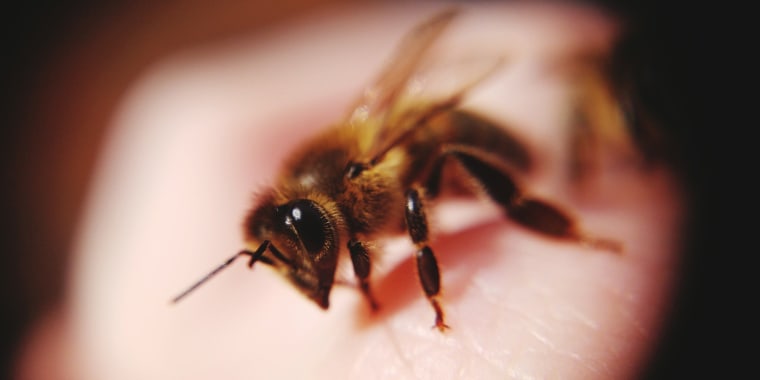To treat muscle pain, a woman in Spain sought out live bee sting acupuncture, a therapy involving strategically-placed bee stings. The 55-year-old woman attended monthly sessions for two years, but on her last visit, she went into anaphylactic shock and later died of a stroke, according to a recently published case study.
For many, avoiding bee stings sounds like common sense. But others believe apitherapy — which uses honey, royal jelly or live bee venom for treatments — is safe because it falls under complementary therapies. What’s more, some celebrities promote bee sting therapy as an ancient treatment for reducing inflammation and scarring.
But there’s no evidence live bee venom treats pain, inflammation or, well, anything.
“It is uncontrolled and potentially dangerous,” said Dr. Dean Mitchell, clinical associate professor at Touro College of Osteopathic Medicine in New York. “I am open to a lot of things. But I would like more literature and reporting (on bee sting acupuncture).”
There’s little to no research on apitherapy. While the case study notes this is the first reported death from apitherapy, experts believe allergic reactions happen all the time with this treatment.
“You are freaking injecting someone with bee venom,” said Dr. Adam Friedman, an associate professor of dermatology at George Washington School of Medicine and Health Sciences. “I am sure allergic reactions happen more than we think.”
Apitherapy seems to be used most commonly for the treatment of multiple sclerosis, pain and inflammation.
“It kind of makes sense. While the stings hurt, they can kind of (stop) the nerve’s capacity to send out signals,” said Friedman.
This would, in theory, provide relief from pain.
But doctors have no idea how bee sting therapy would even work, stressed Dr. Ricardo Madrigal-Burgaleta, author of the case study from the Journal of Investigational Allergology and Clinical Immunology.
“Apitherapy promises — by a completely unknown mechanism and with no clinical evidence — to cure a wide range of maladies,” he said via email.
Even though the patient had previously undergone bee sting acupuncture without experiencing a reaction, her severe allergic response isn’t unusual. People need to be exposed to an allergen to develop an allergy, what's known as sensitization.
“Sensitization is clearly facilitated by intermittent exposure patterns, such as repeated bee stings over a period of time,” said Madrigal-Burgaleta.
Doctors can’t predict how many exposures it takes for an allergy to develop.
“It could be your 10th injection or it could be your 50th when you have the severe reaction,” Mitchell said. “That is what is so critical and deceptive.”
While more research needs to be done on apitherapy, there is evidence manuka honey promotes wound healing and acts as an antimicrobial, said Friedman. However, this is medical manuka honey not just any honey people see on grocery stores shelves.
“It is sterilized,” he said. “It is a medical product.”
The bottom line? Skip the bee stings.
“Be extremely careful,” Madrigal-Burgaleta said. “The risk may overwhelm the intended benefit and you might very well be completely oblivious of it.”
